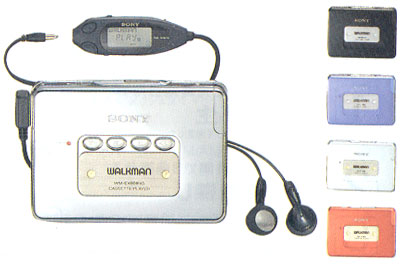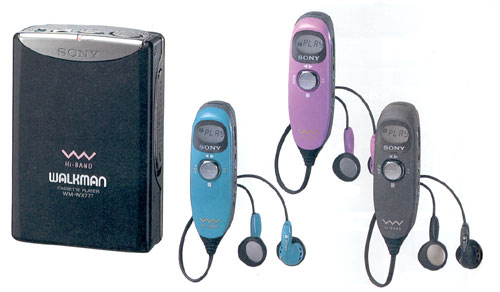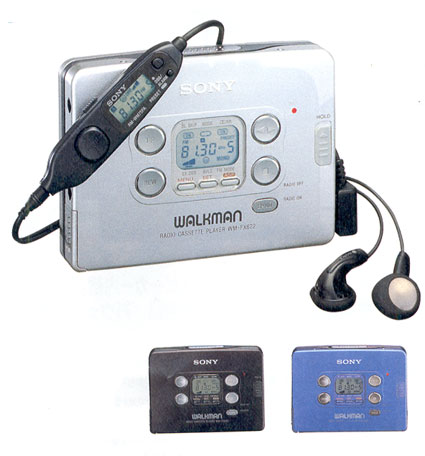
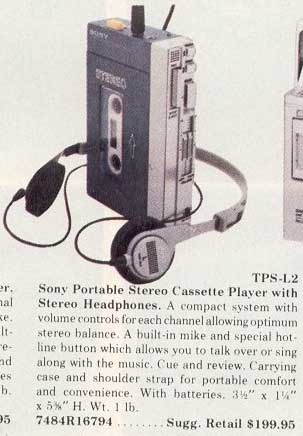
TPS-L2
1979. Sony’s first portable stereo cassette player. The is the baby that started it all. It was a gradual hit in Japan in 1979, and released in the US a year later. The original version featured a well-crafted cassette player in a blue and silver chassis. A pleather pouch allowed the user to move about in freedom and wear the stereo on the hip. A second version sported the oh-so-familiar “walkman” logo in silver. The TPS-L2 featured a “Hot Line” button–the user presses a button to turn off the music and turn on a microphone to drive amplified ambient noise (like someone talking) through the headphones. This was a common feature during this era. Also shown is an ad from a 1981 catalog for the TPS-L2–notice there is no mention of the word “walkman!” Interstingly enough, the Walkman is a term that almost never was–Sony originally marketed this unit in the US as the Soundabout, wound up using the name already popularized in Japan. The Soundabout name was not forgotten, however. Sony used it for their AM-FM/portable cassette recorder a year or so later.



WM-1
1981. Another behemoth in the Walkman series. Not quite as neat as the original, but still a nice model. This model included a strap as well as a belt clip on the back (assumedly to market to both sexes), dual headphone jacks, LED battery indicator and recessed volume knob. Again, this model sold remarkably well, and the 80s began with every person below 20 wanting a personal, portable stereo. View close-up pictures of top, and side.

WM-2
1981. This one brought the portable cassette player market to a new level. The design is pretty amazing–the player is only slightly larger than the cassette itself. The chassis is metal, and check out those hi-tech buttons! Again, the Walkman rage was in full force at this time, so this model is fairly common.

WM-3
1981. The next generation of the WM-1. A little more bulky than the WM-2, but had all of the features of the previous years’ TPS-L2 and Walkman, including twin headphone jacks. Considered the Cadillac of portables at this time, as it was the most expensive but provided the nicest sound. This particular model is a little tough to find these days, perhaps because it was competing against its more affordable and smaller brother, the WM-2.

SRF-80W
1980. The SRF-30W was actually the first FM tuner in Sony’s Walkman line, but we’re attracted to the SRF-80W. Check out that oversized tuning knob–it makes for very accurate tuning. But the icing on the cake is undoubtedly its detachable boombox-style base!
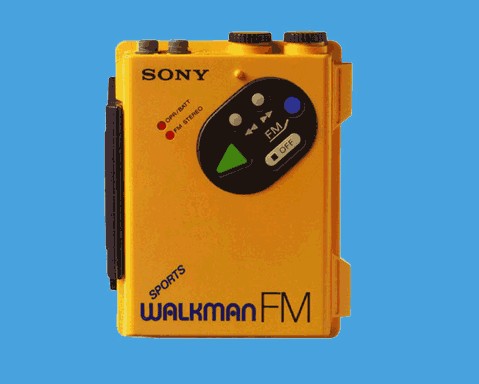
WM-F5
1982. Portable stereo collectors would rank this as a worthy find, Sony’s premiere release in the insanely successful Sports Series. This is the only model in the Sports line we like, probably because it just screams 1982. It was sleak and functional, but the design nonetheless departed from the “traditional” black and silver boxy portable stereos of the day. The Sports line was built for joggers, cyclists, or any person outdoors and on the go. Joints contained gaskets and buttons were covered with rubber to resist shock and water, and the bright yellow color served to, um…irritate people?

WM-F2
1982. Another holy grail is the WM-F2, Sony’s first tuner/cassette recorder Walkman. This released upped the ante from the WM-2 by adding more functionality, but the same sleak all metal chassis sweetens the package. Incredibly sexy design even by today’s standards, we contend the F2’s look makes current day bubble-shaped portables look like cheap plasticky pigs.

WM-F30
1984. Sony pushes the envelope with even more functionality. Check out the WM-F30, complete with TV sound! Slightly chunky looking, but Sony was the first to complement VHF tv audio with AM and FM. Uncommon, but these still pop up on occasion at tag sales and flea markets.

WM-R2
1982. Sony’s first recording Walkman. Yes, another valuable model. Yes, we want one.

WM-F107
1983. Okay, there are two Sports models we like. This is the other, a solar-powered model. Unsure if it was ever available in the U.S.
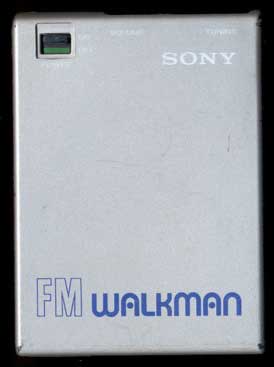
SRF-30W
1981. Minimalist design is the trait that comes to mind with this model. This was the first tuner-only model in the Walkman line, and it’s probably the one that pops into the average person’s head when they hear the word “Walkman.” This makes sense, the SRF-30W was a big seller back in the early 80s–it was affordable, small and it performed well.

WM-F100
1989. The 10-year anniversary model. This was the smallest tuner-cassette Walkman to date, “design and production based on the concept of fantastic sound anytime, anywhere.”

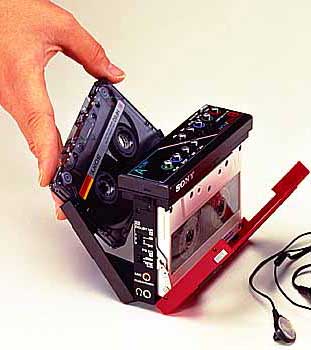
WM-W800
1985. This has got to be the most unique and over-the-top Walkman ideas of all time–a portable stereo with dual cassette capability! One side plays, the other plays and records. Sold around 1985, the WM-W800 was priced at around $150. Here’s one of Sony’s press pictures.

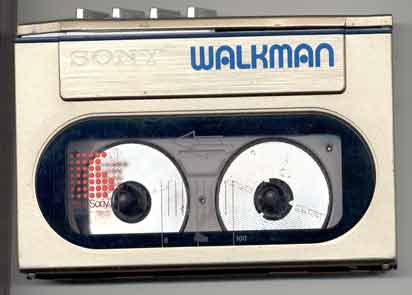
WM-10
1983. Again, Sony sets the standard for what all portable stereos should be. Late in the year, Sony released the WM-10, the smallest, best-sounding cassette player ever. Only slightly larger than the cassette itself, this Walkman featured Dolby noise reduction and new engineering–specifically, an electronically controlled motor speed that resulted in stable sound and low “wow.” In 1983, this was on everyone’s Christmas list. The silver models seem to pop most frequently, but on occasion you may find one in gold.

WM-F1
1983. We puzzled with this one–we find no indication that this model was sold before the WM-F2. So why the lower model number? Perhaps in Japan this actually was released first. It’s not at all like the WM-F2, it’s larger, mostly plastic and lacks the futuristic looks. It did however sport dual headphone jacks, local/dx tuning switch and a hefty belt clip and strap. Sold for under $90 new.

WM-8
1984. Plain-jane cassette player. What’s with the maple leaf, eh?

WM-DD
198?. I don’t believe this particular model ever reached US shores. This Walkman demonstrates Sony’s departure from the belt-driven capstan mechanism, utilizing a “disc drive” capstan. The result is a more durable walkman with lower wow and flutter. This bright red beauty was found in Europe, where Sony apparently felt more comfortable marketing a wider variety of models in various colors. In America, the average ’80s Sony Walkman was black, silver or possibly a sporty yellow.
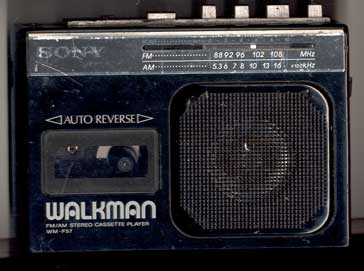
WM-F57
1986. What the…? For years, Sony marketed the Wakman as a personal stereo experience until this one. The WM-F57 was outfitted with a tiny speaker elmininating the need for headphones. This model shares the same chassis as the WM-F77, my favorite Sony Walkman of all time. It has auto-reverse, local/dx FM sensitivity switch.

WM-60
198?. We’ve got to thank our friend Jeroen Morrien of the Netherlands for bringing this terrific Walkman to our attention. This is clearly of 1985 or 1986 vintage, yet it’s equipped with two headphone jacks. How retro. The five-band eq was very much in vogue in the mid to late ’80s. Very sharp model and not a popular model. Great pic, thanks Jeroen!!


WM-F18
1985. My mom shelled out well over $80 to Caldor for this model. The chassis feels a little platicky, but it’s got everything you could want: auto- reverse, graphic eq, direction change and indicator, FM sensitivity and Dolby NR switch. I recently found another for $15, NOS (new old stock) still in the box. Who says you need Ebay to find these vintage gems? Here’s the box.
A Note on Sony Model Numbers: Stereo cassette players in the Walkman line originated with a “WM” followed by numbers and/or letters. The “F” in the model indicates the unit contains a tuner; and “R” indicates a recordable; absence of a letter after the dash indicates a cassette player model. The SRF line consists are tuner-only portables (SRF=Stereo Radio FM?)

